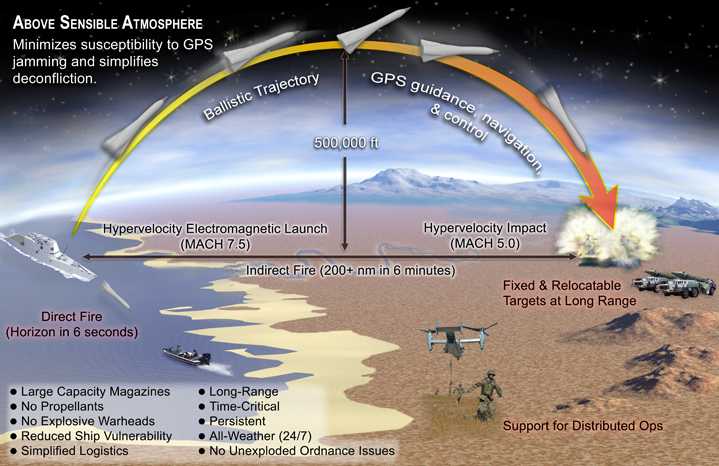|
A Rail Gun operates by making use of the Lorentz force created on a moving armature. The gun consists of two parallel rails electrically connected via an armature which holds the projectile. Current from the power source is sent down one rail, across the armature, and then down through the other rail back to the power source. This current flow creates a magnetic field around the armature, generating a propulsive force which slides it down the rails. With large currents, railguns have the ability to produce great accelerations and thus high muzzle velocities, without the hazards of chemical explosive charges used in conventional guns. This reduces the vulnerability of the ship to damage, as there are no magazines, only shell rooms, and the shells themselves may not contain a burster. The hypersonic velocities generated give the projectiles large kinetic energies, long range, and short flight times. BAE Systems won a contract to deliver a 32 megajoule lab launcher in June 2007 to the Office of Naval Research (ONR) Electromagnetic Launch Facility, located in Virginia at the Naval Surface Warfare Centerís Dahlgren Division Laboratory. On 31 January 2008, test firing began with this launcher. The railgun was fired at 10.64MJ (megajoules) and the 7 lbs. (3.2 kg) test slug projectile attained a muzzle velocity of 8,268 fps (2,520 mps). The following datapage is constructed from public materials released by the US Navy concerning a "Notional Railgun for Destroyers" with a bore of 150 mm (5.9"). In this Notional Railgun design, the projectile is encased within a sabot which provides a means of putting an aerodynamically shaped projectile into a rectangular gun barrel. The sabot together with the propelling armature is discarded after the assembly clears the muzzle. |

Proposed Rail Gun Operation
|
| .
|